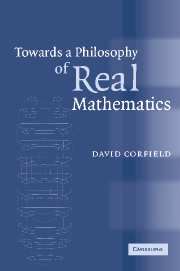Book contents
- Frontmatter
- Contents
- Preface
- 1 Introduction: a role for history
- PART I HUMAN AND ARTIFICIAL MATHEMATICIANS
- 2 Communicating with automated theorem provers
- 3 Automated conjecture formation
- 4 The role of analogy in mathematics
- PART II PLAUSIBILITY, UNCERTAINTY AND PROBABILITY
- PART III THE GROWTH OF MATHEMATICS
- PART IV THE INTERPRETATION OF MATHEMATICS
- Appendix
- Bibliography
- Index
4 - The role of analogy in mathematics
Published online by Cambridge University Press: 22 September 2009
- Frontmatter
- Contents
- Preface
- 1 Introduction: a role for history
- PART I HUMAN AND ARTIFICIAL MATHEMATICIANS
- 2 Communicating with automated theorem provers
- 3 Automated conjecture formation
- 4 The role of analogy in mathematics
- PART II PLAUSIBILITY, UNCERTAINTY AND PROBABILITY
- PART III THE GROWTH OF MATHEMATICS
- PART IV THE INTERPRETATION OF MATHEMATICS
- Appendix
- Bibliography
- Index
Summary
The enrapturing discoveries of our field systematically conceal, like footprints erased in the sand, the analogical train of thought that is the authentic life of mathematics.
(Rota in Kac et al. 1986: ix)INTRODUCTION
When mathematicians talk informally about a theory, their metaphors and similes often reveal something about their conceptualisation which too often goes missing from the papers and monographs they write. The topologist Solomon Lefschetz describes, for instance, how back in the 1920s he ‘planted the harpoon of algebraic topology into the body of the whale of algebraic geometry’ (1971: 13). By this he means that at that time algebraic geometry encompassed a large amount of rather poorly structured theory. Algebraic topology was a newly created tool which Lefschetz could employ to capture and systematise the older theory. There is also an allusion to death in his metaphor which agrees well with mathematicians' use of this word to describe a theory which has been ‘killed off’ by being worked out.
A more explicit similarity lies behind the following statement: ‘The zeta function of a field is like the atom of physics … we will show how to split it via group theory’ (Stark 1992: 366). While we have two objects which at some point in their careers were profitably split, revealing in each case important information about the relation of the whole to its parts, I imagine that when Stark wrote this he did not believe that his comparison could be pushed too far.
- Type
- Chapter
- Information
- Towards a Philosophy of Real Mathematics , pp. 80 - 100Publisher: Cambridge University PressPrint publication year: 2003



